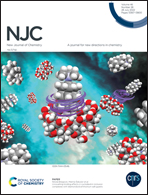Well-constructed approach of exceptionally water-stable (mesoporous SiO2)-on-(microporous Cu-BTC) composite for efficient methylene blue capture†
Abstract
Cationic methylene blue (MB) capture with classical Cu-BTC is definitely restricted and challenged by its water instability issue. Thus the structural stability of Cu-BTC in the presence of moisture is a crucial issue that has to be urgently resolved. In the present special contribution, we propose a novel strategy to grow mesoporous SiO2 on the surface of microporous Cu-BTC to prepare a (mesoporous SiO2)-on-(microporous Cu-BTC) composite by a facile hydrothermal synthesis method, exhibiting remarkable hydrothermal stability and MB capture ability. These novel SiO2-on-(Cu-BTC) composites were systematically characterized and their structural differences compared through powder X-ray diffraction, nitrogen adsorption–desorption, scanning electron microscopy, X-ray photoelectron spectroscopy, Fourier transform infrared spectroscopy, etc. Thanks to its permeable mesoporous SiO2 shell, exposed active sites on the Cu-BTC surface, and protective shell, this (mesoporous SiO2)-on-(microporous Cu-BTC) exhibited higher MB adsorption stability than pure Cu-BTC crystal, impressively retaining its structural integrity, even when soaked in neutral, strong acidic, strong alkali, or boiling aqueous conditions. Our work could open up a novel design concept and synthetic strategy to construct other stable MOF-based adsorbents, promoting their potential development in wastewater purification.



 Please wait while we load your content...
Please wait while we load your content...